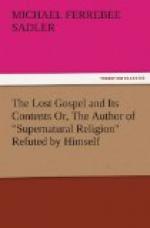If the reader compares this with the accounts in any one of the Four, he will find that it gives the fullest list of our Lord’s appearances which has come down to us, and this, be it remembered, forming part of the most categorical declaration of what the Gospel is, to be found in the New Testament. [196:1]
A man, then, writes in A.D. 57 or earlier, that another, Who had died in A.D. 32 had been seen by a number of persons, and among these, by 500 persons at once, of whom the greater part were alive when he wrote, and implying that the story had been believed ever since, and received by him (the writer) from those who had seen this Jesus, and that the fact was so essential to the religion that it was itself called “the Gospel,” a name continually given to the whole system of Christianity, and moreover that he himself, when in company with others, had seen this Jesus at noon-day, and, the history asserts, had been blinded by the sight. Now let the reader recall to his mind any public man who died twenty-five years ago, that is, in 1850, and imagine this man appearing, not as a disembodied spirit, but in his resuscitated body to first one of his friends, then to eleven or twelve, then to another, then to five hundred persons at one time, and a flourishing and aggressive institution founded upon this his appearance, and numbers of persons giving up their property, and breaking with all their friends, and adopting a new religion, and a new course of life of great self-denial, and even encountering bitter persecution and death, simply because they believed this man to be alive from the dead, and moreover some professing to do miracles, and to confer the power of doing miracles in the name and by the power of this risen man.
Let the reader, I say, try to imagine all this, and then he will be able to judge of the credulity with which the author credits his readers when he writes:—
“All history shows how rapidly pious memory exaggerates and idealizes the traditions of the past, and simple actions might readily be transformed into miracles as the narrative circulated, in a period so prone to superstition, and so characterized by love of the marvellous.” (Vol. ii. p. 209.)
“All history,” the author says; but why does he not give us a few instances out of “all history,” that we might compare them with this Gospel account, and see if there was anything like it?
Such a story, if false, is not a myth. A myth is the slow growth of falsehood through long ages, and this story of the Resurrection was written circumstantially within twenty years of its promulgation, by one who had been an unbeliever, and who had conferred with those who must have been the original promoters of the falsehood, if it be one.




